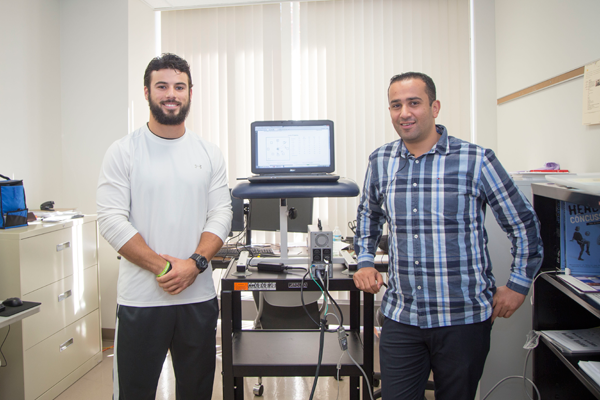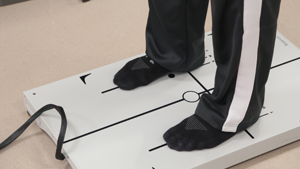UM-Flint Professor of Physical Therapy Partners with Area High Schools on Concussion Research and Awareness

Mitch Babcock leaned forward, keeping his arms to his side. The 2nd-year student in the physical therapy DPT program at UM-Flint stood on the force plate, a platform that can gauge various aspects of a person's balance.

Babcock's motions triggered the corresponding movements of a miniature avatar on the computer screen toward a small box on the screen.
Following the instructions of Bara Alsalaheen, PhD, an assistant professor of physical therapy at UM-Flint, Babcock guided the avatar to eight boxes surrounding it by leaning his body in different directions.
The test, within a university lab at the William S. White Building, took about five minutes but calculated a host of data, including Babcock's reaction time, movement velocity, stability, and ability to control the direction of his movements.
"This is a way to put a number to those aspects of balance, which otherwise we can't quantify," Alsalaheen, explaining the device.

The university professor, other faculty members, and several graduate students have utilized the force plate and other technologies at four local high schools this year as part of concussion research spearheaded by Alsalaheen.
Alsalaheen and his team are testing the viability of various equipment and technologies, but also gathering data for area schools and its students that could help monitor a students' recovery (or lack of) from a concussion.
"The testing that is done through our research helps the schools by having more arrows in their quiver during the difficult conversations about returning to play (after a concussion). It is very helpful to athletic trainers and coaches in schools," Alsalaheen said.
The UM-Flint professor started the research project this year but has ambitious long-term plans. He and his team are looking to raise the level of collaboration between area medical providers, schools, and researchers on how to assess and treat concussions in high school adolescents.
"Our main goal this year is to build a foundation with the schools we are working with. Our plan is to establish a longitudinal relationship in which we will be able to track the athletes as they play in high school, follow their balance, cognitive, and visual motor performance, " Alsalaheen said.
So far, the research crew from UM-Flint has worked with Fenton High School, Holly High School, Freeland High School, and Heritage High School in Saginaw.
Alsalaheen said he has been in discussions with several other districts and hopes to build the base over time. His work this year has been funded through UM-Flint Office of Research & Sponsored Programs grants and via financial support from the physical therapy department.
Mitch Smelis, the athletic trainer at Fenton High School, said Alsalaheen has been "awesome" at being a "good steward of the community" by looking to work in practical ways with the schools.
"He is interested in building a long-term relationship," said Smelis.
For the past decade, the high school has been conducting its own series of tests on students playing sports at the beginning of the year. It keeps the data to help gauge a student's health after possible concussions.
"It helps to have a comparison for what is approximately normal for them," said Smelis, who works for Physiotherapy Associates and is contracted out to work in the school. He has been at Fenton High School for nearly two decades.
The work by the UM-Flint team should add to that arsenal, Smelis said. But also help dispel myths such as football players being the only athletes susceptible to concussions.
"I think the more people we can get involved in it, the better, because there is strength in numbers. It definitely does help," Smelis said.
The UM-Flint researchers are focusing on practical data. For example, the force plates can cost $15,000, making them too expensive for many schools. So the research team is testing multiple balance devices to see if low-cost methods are viable and safe and can be used instead.
Also, the data gathered from the force plates can be taken to hospitals and other medical providers after a student suffers a concussion so there is a comparison. Alsalaheen said low-cost equipment, in which trainers can test students on the playing field, are being used too. Booklets, in which students read off numbers in increasingly complex patterns, have been provided to the participating schools, he said.
"This is a quick sidelines assessment tool and once again it becomes very handy to the school," he said.
Alsalaheen said building awareness and response to concussions is "a collective effort" for the community as a whole. He and his department, along with the Center for Cognition and Neuroethics held a seminar this summer for area athletic trainers, coaches, and other school personnel about concussion management and assessment.
Stacy Frye, MD, who specializes in pediatric, orthopedics and sports medicine at McLaren Medical Group in Grand Blanc and treats multiple concussion patients daily, has had informal talks with Alsalaheen about his research.
"I think it's fantastic," Frye said about the UM-Flint team's focus on concussion research. "It gives a whole other level of support of why getting the most information and most up-to-date information (on concussions) is important."
PHOTO: UM-Flint DPT student Mitch Babcock and Assistant Professor of Physical Therapy Bara Alsalaheen, PhD
Contact University Relations staff writer Robert Gold with comments, questions, and ideas at goldr@umflint.edu, (810) 424-5596, or on Twitter, @writerobert.
Related Posts
No related photos.
- College of Health Sciences
- Community
- Graduate Programs
- Health & Safety
- Physical Therapy
- Research
- Technology
- University News
UM-Flint News
The Office of Marketing & Communications can be reached at mac-flint@umich.edu.